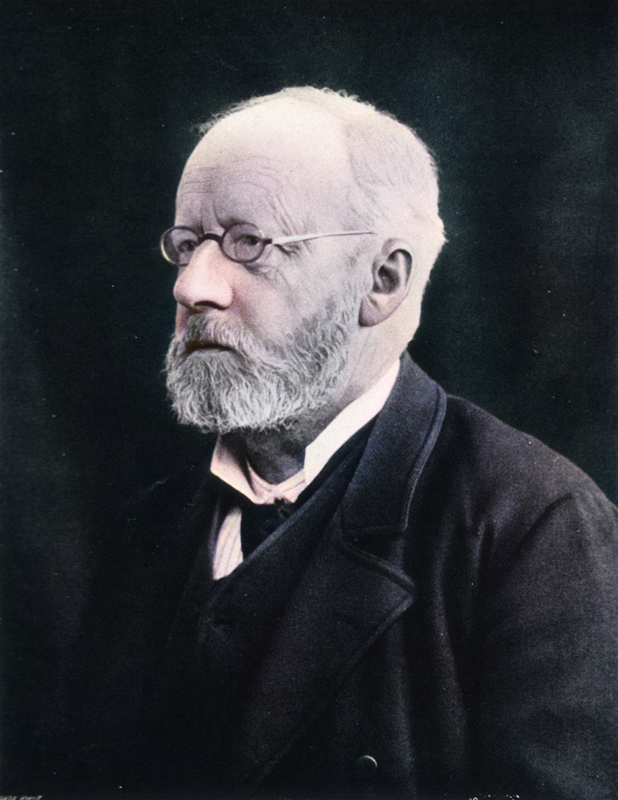
Theodor Albrecht Edwin Klebs (6 February 1834 – 23 October 1913)
On February 6, 1834, Swiss-German pathologist Theodor Albrecht Edwin Klebs was born. Klebs is mainly known for his work on infectious diseases. His works paved the way for the beginning of modern bacteriology, and inspired Louis Pasteur and Robert Koch. He was the first to identify a bacterium that causes diphtheria, which was called Klebs–Loeffler bacterium.
Medical Studies in Königsberg and Würzburg
Edwin Klebs was born in Königsberg, Province of Prussia. Ignoring the family tradition to study law, he turn towards medicine and studied for five semesters at the University of Königsberg with embryologist and anatomist Martin Rathke, physician and physicist Hermann von Helmholtz,[6] and others. In 1855 at age twentyone, he went to Würzburg to study at the University of Würzburg under the then popular Rudolf Virchow,[2] known for his advancement of public health and often referred to as the “father of modern pathology“[2]. Klebs received his doctorate at the University of Berlin in 1858, where he presented his dissertation in Latin on types of tuberculosis which affect the intestines, part of a general subject which commanded his investigative interests throughout his life. He achieved his habilitation at the University of Königsberg the following year. After practicing for a short time in Königsberg, Klebs was appointed privatdocent in general pathology and assistant in the Physiological Institute under Wittich.[4]
Assistant of Rudolf Virchow
Klebs was an assistant to Virchow at the Charité in Berlin from 1861 until 1866, when he became a professor of pathology at the University of Bern in Switzerland. He served as a military physician for the Prussian Army in 1870 during the Franco-Prussian War. Klebs taught at Würzburg from 1872 to 1873, at Prague from 1873 to 1882, and at Zürich from 1882 to 1892. Because of disagreements with the rest of the faculty, the impetuous Klebs resigned from Zürich in 1893 and ran an unsuccessful private business in Karlsruhe and Strassburg in 1894.
Contributions to Pathological Anatomy
Klebs’ contributions to pathological anatomy and physiology included the first experimental production of valvular disease of the heart. He preceded Robert Koch in studying the bacteriology of traumatic infections, and in 1876 he succeeded in producing endocarditis by mechanical means combined with general infection.
Klebs’ Bacteriological Tests
Klebs identified four “Grundversuche” (fundamental tests) that provided a basis for his own research strategy, as well as general bacteriological research. According to Klebs, the bacteriological tests consist of the following postulates:
- all bacteria are pathological
- bacteria never occur spontaneously
- every disease is caused only by bacteria
- the bacteria that cause distinguishable disease are distinguishable.
Although some of these hypotheses are literally false, they are in general the foundation of modern experiments in bacteriology
Further Research
From researches on tuberculosis he was able to produce bovine infection by means of milk thereby establishing the bovine origin of the disease. In 1878 he successfully transmitted syphilis to monkeys, antedating the experiments of Élie Metchnikoff [7] and Émile Roux by 25 years. In 1883 Klebs successfully identified the bacterium Corynebacterium diphtheriae as the etiological cause of diphtheria. This bacterium is also known as the Klebs-Löffler bacillus. He also studied malaria, hemorrhagic pancreatitis, and acro-megaly in 1884, two years before Pierre Marie.
Apart from monographs and articles, he produced a handbook of pathological anatomy (1869–76) and a treatise on general pathology (1887–89).[1] Klebs also took an active part in the foundation of three important medical journals, namely, the Correspondenz-Blatt für Schweizer Aerzte (1871), which some years ago was renamed Schweizer medizinische Wochenschrift, the Archiv für experimentelle Pathologie und Pharmacologie (1873) and the Prager Medizinische Wochenschrift (1876).
The Malaria Disaster
Klebs made several mistakes about the causes of infectious diseases. He thought that malaria was caused by a bacterium, which he and Corrado Tommasi-Crudeli claimed to have isolated from the waters of the Pontine Marshes in Roman Campagna in 1879. They named it Bacillus malariae and believed it was the cause of malaria because infected rabbits developed fever and enlarged spleens, symptoms of the disease. They believed it was transmitted through contaminated water or air. Despite support from leading malariologists of the time, the theory was proven wrong by Charles Louis Alphonse Laveran,[11] who discovered in 1880 that malaria was actually caused by a parasite, and George Miller Sternberg, who showed in 1881 that the bacillus did not cause specific symptoms of malaria. The mosquito-malaria theory was finally proven in 1898.
Later Life
From 1896 to 1900 Klebs taught at Rush Medical College in Chicago, United States. From 1905 to 1910 he was a private researcher in Berlin, after which he returned to Switzerland, living with his oldest son in Lausanne. Klebs died in Bern in 1913, aged 79.
The History of Microbiology in English – Microbiology with Sumi, [8]
References and Further Reading:
- [1] Edwin Klebs, German physician and pathologist, at Britannica Online
- [2] Rudolph Virchow – the Father of Modern Pathology, SciHi blog, Oct 13, 2013.
- [3] Leona Baumgartner: Edwin Klebs — A Centennial Note, N Engl J Med, 1935; 213:60-63, July 11, 1935,DOI: 10.1056/NEJM193507112130209.
- [4] Edwin Klebs (1834-1913) Peropathetic Bacteriologist, JAMA. 1968;204(8):729-730. doi:10.1001/jama.1968.03140210085024
- [5] Edwin Klebs at Wikidata
- [6] Hermann von Helmholtz and his Theory of Vision, SciHi Blog, August 31, 2015.
- [7] Ilya Mechnikov and the Macrophages, SciHi Blog, May 16, 2015.
- [8] The History of Microbiology in English – Microbiology with Sumi, Microbiology with Sumi @ youtube
- [9] Julius Pagel: Klebs, Edwin, in: Biographisches Lexikon hervorragender Ärzte des neunzehnten Jahrhunderts. Berlin und Wien 1901, Sp. 863 f.
- [10] Garrison, F.H. (1913). “Edwin Klebs (1834-1913)”. Science. 38 (991): 920–921.
- [11] Alphonse Laveran’s Discovery and the Fight against Malaria, SciHi Blog
- [12] Timeline of German Military Doctors, via DBpedia and Wikidata





